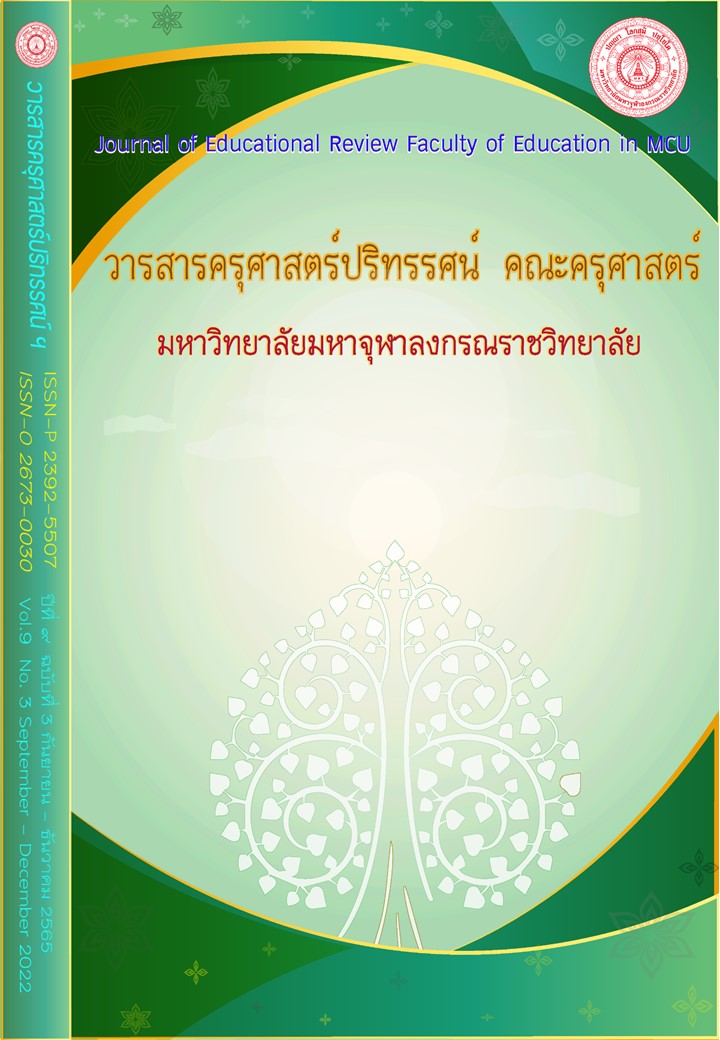THE PRIORITY NEEDS OF DEVELOPING ACADEMIC MANAGEMENT OF DENLA BRITISH SCHOOL BASED ON THE CONCEPT OF DIFFERENTIATED INSTRUCTION
Main Article Content
Abstract
The purposes of this research article were to study the need of developing academic management of Denla British School based on the concept of differentiated instruction. This research was a descriptive research. The informants were 170 directors, teachers and Year 8-10 students. The research instrument was a questionnaire. Results showed that 1) The current stage of developing academic management of Denla British school base on the concept of differentiated instruction characteristics is moderate (M=3.486). 2) The data were analyzed using priority needs index modified (PNIModified). The results showed that the highest priority needs for developing academic management based on the concept of differentiated instruction is assessment and evaluation (PNIModified=0.272) with the highest priority needs of its sub-elements being criteria for student assessment and evaluations (PNIModified=0.273) and implementation of assessment and evaluation (PNIModified=0.271), respectively. The lowest priority needs is curriculum development (PNIModified=0.244).
Article Details

This work is licensed under a Creative Commons Attribution-NonCommercial-NoDerivatives 4.0 International License.
ทัศนะและความคิดเห็นที่ปรากฏในบทความในวารสารฉบับนี้ถือเป็นความรับผิดชอบของผู้เขียนบทความนั้นเพียงผู้เดียว และไม่ถือเป็นทัศนะและความรับผิดชอบของกองบรรณาธิการ
กองบรรณาธิการขอสงวนสิทธิ์ในการคัดเลือกบทความลงตีพิมพ์และจะแจ้งให้เจ้าของบทความทราบหลังจากผู้ประเมินบทความตรวจอ่านบทความแล้ว
ต้นฉบับที่ได้รับการตีพิมพ์ในวารสารครุศาสตร์ปริทรรศน์ คณะครุศาสตร์ มหาวิทยาลัยมหาจุฬาลงกรณราชวิทยาลัย ถือเป็นกรรมสิทธิ์ของคณะครุศาสตร์ มหาวิทยาลัยมหาจุฬาลงกรณราชวิทยาลัย ห้ามนำข้อความทั้งหมดหรือบางส่วนไปพิมพ์ซ้ำ เว้นเสียแต่ว่าจะได้รับอนุญาตจากมหาวิทยาลัยฯ เป็นลายลักษณ์อักษร
References
กิตติธัช สีหะวงษ์ และคณะ. (2557). การศึกษาสภาพและแนวทางการพัฒนาการประเมินตามสภาพจริงของครู. Humanities and Social Sciences Journal of Graduate School. Pibulsongkram Rajabhat University. 8(1).
จามจุรี จำเมือง. (2552). คู่มือเตรียมสอบผู้บริหารสถานศึกษาและผู้บริหารการศึกษา. กรุงเทพมหานคร: เจริญดีมั่นคง.
ณัฏฐพล ทีปสุวรรณ. (2563). รัฐบาลไทย; ด้านการศึกษา. แหล่งที่มา https://www.thaigov.go.th/news/contents/details/36768 สืบค้นเมื่อ 8 ธ.ค. 2563.
บุญยฤทธิ์ ปิยะศรี. (2556). รูปแบบการพัฒนาวิชาชีพครูเพื่อเสริมสร้างสมรรถนะการสอนที่เน้นความ แตกต่างระหว่างบุคคล. ดุษฎีนิพนธ์ครุศาสตรดุษฎีบัณฑิต. มหาวิทยาลัยศิลปากร.
ประยุทธ์ จันทร์โอชา. (2563). รัฐบาลไทย; คำกล่าวสุนทรพจน์. แหล่งที่มา https://www.thaigov.go.th/news/contents/details/34307 สืบค้นเมื่อ 1 ธ.ค. 2563.
ปรียาพร วงศ์อนุตรโรจน์. (2543). การบริหารงานวิชาการ. กรุงเทพมหานคร: ศูนย์สื่อเสริมกรุงเทพฯ.
พระราชบัญญัติการศึกษาแห่งชาติ พ.ศ. 2542. (2542). ราชกิจจานุเบกษา เล่ม 116 ตอนที่ 74 ก หน้า 8. (19 ส.ค. 2542).
พันธวิชญ์ เลี้ยงชีพชอบ. (2561). การพัฒนาทรัพยากรมนุษย์เพื่อนาประเทศไทยสู่ประเทศไทย 4.0. กรุงเทพมหานคร: จุฬาลงกรณ์มหาวิทยาลัย.
มาเรียม นิลพันธุ์, ศิริวรรณ วณิชวัฒนวรชัย, อธิกมาส มากจุ้ย และรุจิราพร รามศิริ. (2555). การพัฒนานวัตกรรมการจัดการเรียนรการสอนที่เน้นความแตกต่างระหว่างบุคคล. รายงานการวิจัย. มหาวิทยาลัยศิลปากร.
ลักษมี แป้นสุข. (2562). ผลการจัดการเรียนรู้ตามความแตกต่างระหว่างบุคคลโดยใช้เทคนิคผังกราฟิกที่มีต่อทักษะการเขียนเชิงสร้างสรรค์ของนักเรียนชั้นประถมศึกษาปีที่ 4. กรุงเทพมหานคร: จุฬาลงกรณ์มหาวิทยาลัย.
ศศิธร บัวทอง. (2560). การวัดและประเมินทักษะการเรียนรู้ในศตวรรษที่ 21. Veridian E-Journal, Silpakorn University. 10(2).
สุระเชษฐ์ ตรรกโชติ. (2563). การเรียนรู้ที่อยู่ร่วมกับความแตกต่าง. แหล่งที่มา https://www.educathai.com/knowledge/articles/399 สืบค้นเมื่อ 1 ต.ค. 2563.
Beck, C. R. (2001). Matching teaching strategies to learning style preferences. The Teacher Educator. 37(1).
Elizabeth R.H. (2009). Differentiated Instruction and Tiered Assignments. Fisher Digital Publications.
Emily P. (2014). Differentiation: It Starts with Pre-Assessment. Educational leadership. 71(4).
Felder, R. M. & Brent, R. (2005). Understanding student differences. Journal of Engineering Education. 94.
John D. (1897). My Pedagogic Creed. School Journal. 54. 77-80.
Joseph S. et al. (2013). The impact of differentiated instruction in a teacher education setting: successes and challenges. International journal of higher education. 2(3) 2013.
Rogers, K. M. A. (2009). A preliminary investigation and analysis of student learning style preferences in further and higher education. Journal of Further and Higher Education. 33(1).
Sally G. and Jeni W. (2008). Helping your pupils to ask questions. Routledge.
Tomlinson, C.A. (2017). How to differentiate instruction in academically diverse classrooms. 3rd ed. Alexandria, Virginia. USA: ASCD.
Tomlinson, C.A. (2017). How to differentiate instruction in mixed-ability classrooms. 2rd ed. Alexandria, Virginia. USA: ASCD.
Tomlinson, C.A. and Imbeau, M. B. (2010). Leading and Managing a Differentiated Classroom. Alexandria, USA: ASCD.
Tulbure, C. (2011). Do Different Learning Styles Require Differentiated Teaching Strategies. Procedia-Social and Behavioral Sciences. 11. 155-159.


